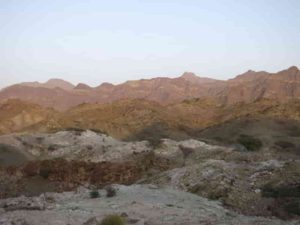
When two of Earth’s tectonic plates collide, the heavier plate is forced underneath and back into the mantle in a process called subduction. During the early stages of newly initiated subduction zones, the uppermost part of the downward traveling plate can detach and accrete to the base of the overriding (upper) plate. Later, these slices can be exposed at Earth’s surface and are known as metamorphic soles.
Soles provide direct evidence of conditions in the subduction zone; however, their interpretation is clouded by uncertainties surrounding how the sole accretes to the base of the upper plate and the process by which it is then exhumed from within the subduction zone. Ambrose et al. attempt to trace this sequence of events by mapping the evolution of the sole’s texture, the arrangement and orientation of a rock’s component minerals. They do so in a region of well-exposed oceanic crust in the United Arab Emirates.
The authors extracted 16 thin sections distributed across a 250-meter exposed section of the sole. The scientists then performed extensive laboratory testing on 10 of the samples. Using the observed mineral distribution and composition, they deduced a gradient in temperature but not pressure across the sole. This gradient implies that the sole attached to the upper plate in layers as the region cooled but that the entire accretion of the sole occurred at depths of 30–40 kilometers.
The study concludes by outlining a three-step sequence for the evolution of the metamorphic sole. At the onset of subduction, the oceanic crust sinks to a depth of 30–40 kilometers and is heated to temperatures of 700°C–900°C. Then, during peak metamorphic conditions, increased viscosity during the formation of a granulite facies (a kind of metamorphic rock that contains minerals) assemblage causes the subduction plate boundary to migrate deeper into the slab, leaving behind the high-temperature portion of the sole. Finally, as the region cools, the sole grows with layers at similar pressures but increasingly lower temperatures.
Reference:
T. K. Ambrose et al, Burial, Accretion, and Exhumation of the Metamorphic Sole of the Oman‐UAE Ophiolite, Tectonics (2021). DOI: 10.1029/2020TC006392
Note: The above post is reprinted from materials provided by Eos, hosted by the American Geophysical Union.










